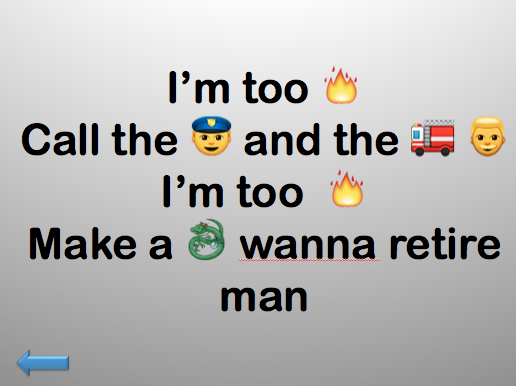Hide & Seek: This game was definitely a hit across the majority of my classes. There was one person as the seeker and one person as the hider. The seeker stood at the front of the room with his/her back facing everyone (eyes closed, too!), then the hider took an egg shaker and walked somewhere in the room, shook the egg, and hid it somewhere. I made sure they were shaking the egg right before they hid it, so the person seeking could get a good idea of where it was in the room. Once the egg was hidden and the hider returned to his/her seat, the seeker had an opportunity to look around for the egg shaker. If it took the seeker a little while, I allowed the class to give hot/cold hints to help out a little. Some adaptations are to do this with two rounds: first one is just the egg shaker, and the second is an egg shaker and wrist bells. I also had some kids pair up, with each team listening for a different instrument sound to really work on teamwork. Otherwise this intervention works well for attention to task and following directions.
Drum Circle (Cont’d): So a few months ago I went to a Drumming & Autism training led by Jim Donovan. He demonstrated some really cool drumming interventions that I was really excited to incorporate with my kiddos, since I was already doing drum circle work with them! At the time, this class was especially having difficulty with some of their relationships/group cohesion, so I was hoping to use drumming to develop some positive interactions and relationships. One game I used from the training used the concept of “The Wave.” First you go around and everyone plays just one hit on their instrument. Then you incorporate what he called a “flurry,” which is just a quick drum roll. Then you can add passing it with eye contact, doing it backwards, adding vocalizations (names, animal noises, opera singing, random sounds, foods, literally anything!). I also like to add funny faces, and something I incorporated for this class was compliments, so they each went around and said something nice about the person sitting next to them. I also asked if they wanted to send anything around — I think at one point we did jokes. But this activity is super flexible for adaptations! It creates a safe environment where everyone can be silly, and also engage in positive interactions.
Boomwhackers: Jim Donovan also showed us some interventions with boomwhackers at the training. With my class, we did some call & response rhythms using different sounds (tapping the floor, tapping them together, tapping our legs), and then one thing I learned at the training was having the students close their eyes and listen to the different sounds and try to repeat my patterns with their eyes closed. Of course, I did not force anyone to close their eyes — I only offered for them to do it if they felt comfortable. Then I asked the students to play the boomwhackers in a scale as I pointed to the letters on the board. I previously worked on chords with this class, so we started building chords and doing different progressions with the boomwhackers. I’d like to try some sort of ensemble work with them some day but haven’t gotten around to it yet!
Ask-It Basket: This is an intervention I used a few times when I was in a mental health facility during my internship. I got the idea when I observed a drug and alcohol rehab group. The therapist asked everyone in the group to write down a question they had and put it in a basket. He then pulled each question out of the basket and the group talked about them. I adapted this idea for my patients, and ultimately used it here at the school for my older students. I gave each student a slip of paper and asked them to write something that was on their mind that day. I collected the slips of paper and redistributed them randomly to the group, so each person had someone else’s paper. Then I asked each student to read the slip of paper they had from another person and pick a song from my list for that person. I went through and played each song live, and I asked each person how they chose that song for that person. I also said at the beginning of the activity that if anyone felt comfortable sharing their thoughts on the song chosen for him/her, they certainly could, but I did not force them. This is a nice way to encourage some group cohesion, positive interaction, and empathy.

